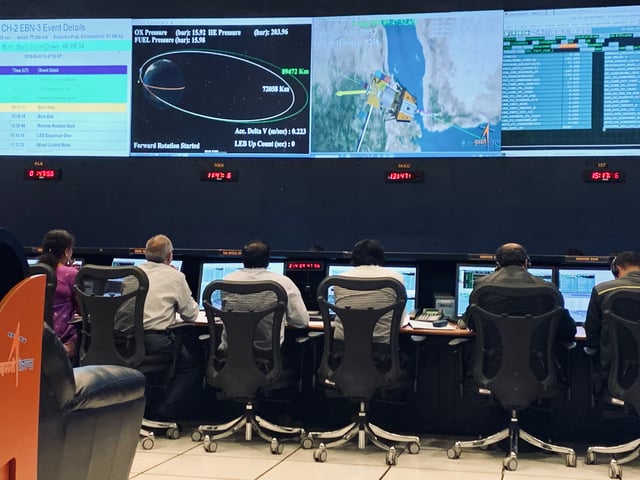Chandrayaan-2
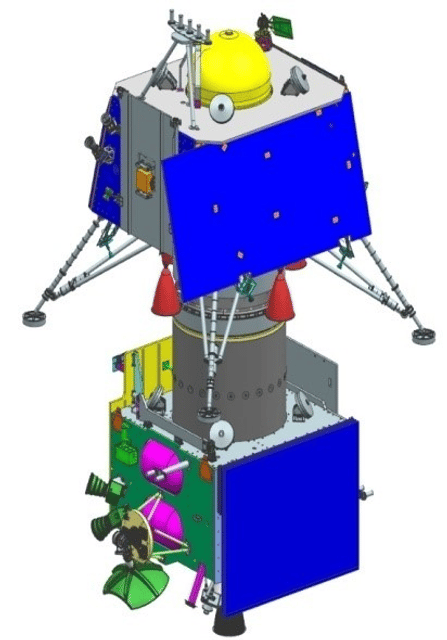
Chandrayaan-2

| Mission type | Lunarorbiter,lander,rover |
|---|---|
| Operator | Indian Space Research Organisation(ISRO) |
| COSPAR ID | 2019-042A |
| SATCAT no. | 44441[157] |
| Website | |
| Mission duration | Orbiter: ~ 7 years Elapsed: 27 daysVikramlander ≤ 14 days[1][2]Pragyan
|
| Spacecraft properties | |
| Manufacturer | Indian Space Research Organisation(ISRO) |
| Launch mass | Combined (wet): 3,850 kg (8,490 lb)[3][4][5]Combined (dry): 1,308 kg (2,884 lb)[6]Orbiter (wet): 2,379 kg (5,245 lb)[4][5]Orbiter (dry): 682 kg (1,504 lb)[6]Vikram
|
| Power | Orbiter: 1 kW[7]*Vikramlander: 650 WPragyan* rover: 50 W |
| Start of mission | |
| Launch date | 22 July 2019, 14:43:12 IST (09:13:12 UTC)[8] |
| Rocket | GSLV Mk III[9][10] |
| Launch site | Satish Dhawan Space Centre Second Launch Pad |
| Contractor | Indian Space Research Organisation(ISRO) |
| Moonorbiter | |
| Orbital insertion | 20 August 2019, 09:02 IST (03:32 UTC)[11][12] |
| Orbital parameters | |
| Periapsis altitude | 100 km (62 mi)[13] |
| Apoapsis altitude | 100 km (62 mi)[13] |
| Inclination | 90° (polar orbit) |
| Moonlander | |
| Spacecraft component | Rover |
| Landing date | 7 September 2019, 01:53 IST (6 September 2019, 20:23 UTC)[14][12] |

Chandrayaan-2 mission explained
Mission Chandrayaan-2 (candra-yāna, transl. "mooncraft";[15][16] pronunciation ) is the second lunar exploration mission developed by the Indian Space Research Organisation (ISRO),[17][18] after Chandrayaan-1.[19][20] It consisted of a lunar orbiter, the Vikram lander, and the Pragyan lunar rover, all of which were developed in India.[21] The main scientific objective is to map and study the variations in lunar surface composition, as well as the location and abundance of lunar water.[22][23]
The mission was launched on its course to the Moon from the second launch pad at Satish Dhawan Space Centre on 22 July 2019 at 2.43 PM IST (09:13 UTC) by a Geosynchronous Satellite Launch Vehicle Mark III (GSLV Mk III).[9][10][24] The craft reached the Moon's orbit on 20 August 2019 and began orbital positioning manoeuvres for the landing of the Vikram lander.[25] Vikram and the rover were scheduled to land on the near side of the Moon, in the south polar region[26] at a latitude of about 70° south at approximately 20:23 UTC on 6 September 2019 and conduct scientific experiments for one lunar day, which approximates two Earth weeks.
However, the lander deviated from its intended trajectory starting at 2.1 kilometres (1.3 mi) altitude,[27] and had lost communication when touchdown confirmation was expected.[28][29] Initial reports suggesting a crash[30][31] have been confirmed by ISRO chairman K. Sivan, stating that the lander location had been found, and "it must have been a hard landing".[32]
Both ISRO and NASA tried unsuccessfully to communicate with the lander for two weeks before the lunar night set in.
The orbiter, part of the mission with eight scientific instruments, remains operational and is expected to continue its seven-year mission to study the Moon.
| Mission type | Lunarorbiter,lander,rover |
|---|---|
| Operator | Indian Space Research Organisation(ISRO) |
| COSPAR ID | 2019-042A |
| SATCAT no. | 44441[157] |
| Website | |
| Mission duration | Orbiter: ~ 7 years Elapsed: 27 daysVikramlander ≤ 14 days[1][2]Pragyan
|
| Spacecraft properties | |
| Manufacturer | Indian Space Research Organisation(ISRO) |
| Launch mass | Combined (wet): 3,850 kg (8,490 lb)[3][4][5]Combined (dry): 1,308 kg (2,884 lb)[6]Orbiter (wet): 2,379 kg (5,245 lb)[4][5]Orbiter (dry): 682 kg (1,504 lb)[6]Vikram
|
| Power | Orbiter: 1 kW[7]*Vikramlander: 650 WPragyan* rover: 50 W |
| Start of mission | |
| Launch date | 22 July 2019, 14:43:12 IST (09:13:12 UTC)[8] |
| Rocket | GSLV Mk III[9][10] |
| Launch site | Satish Dhawan Space Centre Second Launch Pad |
| Contractor | Indian Space Research Organisation(ISRO) |
| Moonorbiter | |
| Orbital insertion | 20 August 2019, 09:02 IST (03:32 UTC)[11][12] |
| Orbital parameters | |
| Periapsis altitude | 100 km (62 mi)[13] |
| Apoapsis altitude | 100 km (62 mi)[13] |
| Inclination | 90° (polar orbit) |
| Moonlander | |
| Spacecraft component | Rover |
| Landing date | 7 September 2019, 01:53 IST (6 September 2019, 20:23 UTC)[14][12] |
History
On 12 November 2007, representatives of the Russian Federal Space Agency (Roscosmos) and ISRO signed an agreement for the two agencies to work together on the Chandrayaan-2 project.[33] ISRO would have the prime responsibility for the orbiter and rover, while Roscosmos was to provide the lander. The Indian government approved the mission in a meeting of the Union Cabinet, held on 18 September 2008 and chaired by Prime Minister Manmohan Singh.[34] The design of the spacecraft was completed in August 2009, with scientists of both countries conducting a joint review.[35][36]
Although ISRO finalised the payload for Chandrayaan-2 per schedule,[37] the mission was postponed in January 2013[38] and rescheduled to 2016 because Russia was unable to develop the lander on time.[39][40] Roscosmos later withdrew in wake of the failure of the Fobos-Grunt mission to Mars, since the technical aspects connected with the Fobos-Grunt mission were also used in the lunar projects, which needed to be reviewed.[39] When Russia cited its inability to provide the lander even by 2015, India decided to develop the lunar mission independently.[38][41]
The spacecraft's launch had been scheduled for March 2018, but was first delayed to April and then to October to conduct further tests on the vehicle.[42][43] On 19 June 2018, after the program's fourth Comprehensive Technical Review meeting, a number of changes in configuration and landing sequence were planned for implementation, pushing the launch to the first half of 2019.[44] Two of the lander's legs got minor damage during one of the tests in February 2019.[45]
Chandrayaan-2 launch was initially scheduled for 14 July 2019, 21:21 UTC (15 July 2019 at 02:51 IST local time), with the landing expected on 6 September 2019.[20] However, the launch was aborted due to a technical glitch and was rescheduled.[46][8][47] The launch occurred on 22 July 2019 at 09:13 UTC (14:43 IST) on the first operational flight of a GSLV MK III M1.[48]
Objectives
The primary objectives of the Chandrayaan-2 lander were to demonstrate the ability to soft-land on the lunar surface and operate a robotic rover on the surface. Scientific goals include orbital studies of lunar topography, mineralogy, elemental abundance, the lunar exosphere, and signatures of hydroxyl and water ice.[49] The orbiter will map the lunar surface and help to prepare 3D maps of it. The onboard radar will also map the surface while studying the water ice in the south polar region and thickness of the lunar regolith on the surface.[50]
Design
The mission was launched on a Geosynchronous Satellite Launch Vehicle Mark III (GSLV Mk III) with an approximate lift-off mass of 3,850 kg (8,490 lb) from Satish Dhawan Space Centre on Sriharikota Island.[3][13][10][51] As of June 2019, the mission has an allocated cost of ₹978 crore (approximately US$141 million) which includes ₹603 crore for space segment and ₹375 crore as launch costs on GSLV Mk III.[52][53] Chandrayaan-2 stack was initially put in an Earth parking orbit of 170 km perigee and 40,400 km apogee by the launch vehicle.[54]
Orbiter
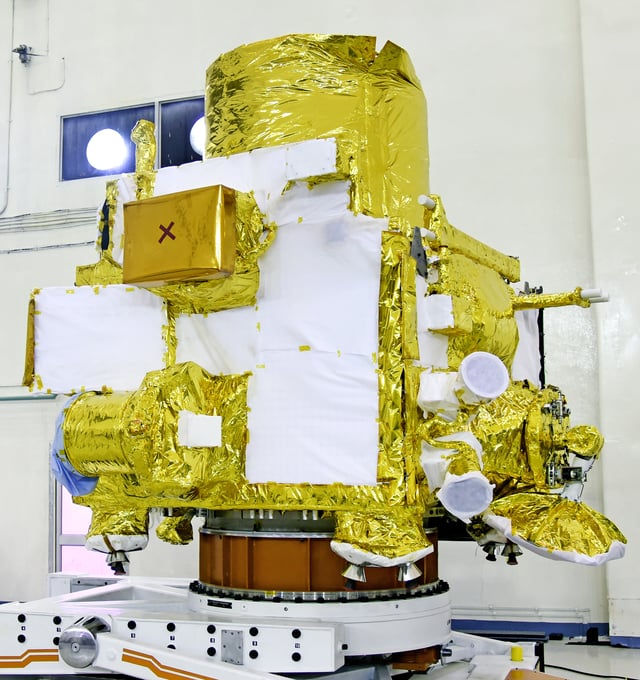
Chandrayaan-2 orbiter at integration facility
As of September 2019, the Chandrayaan-2 orbiter was orbiting the Moon on a polar orbit at an altitude of 100 km (62 mi).[55] It carries eight scientific instruments; two of which are improved versions of those flown on Chandrayaan-1. The approximate launch mass was 2,379 kg (5,245 lb).[4][5][37][56] The Orbiter High Resolution Camera (OHRC) conducted high-resolution observations of the landing site prior to separation of the lander from the orbiter.[55][2] The orbiter's structure was manufactured by Hindustan Aeronautics Limited and delivered to ISRO Satellite Centre on 22 June 2015.[57][58]
Dimensions: 3.2 × 5.8 × 2.2 m[23]
Gross lift-off mass: 2,379 kg (5,245 lb)[3]
Propellant mass: 1,697 kg (3,741 lb)[6]
Dry mass: 682 kg (1,504 lb)[6]
Power generation capacity: 1000 W[23]
Mission duration: approximately 7.5 years, extended from the planned 1 year owing to the precise launch and mission management, in lunar orbit.[1][59]
Vikram lander
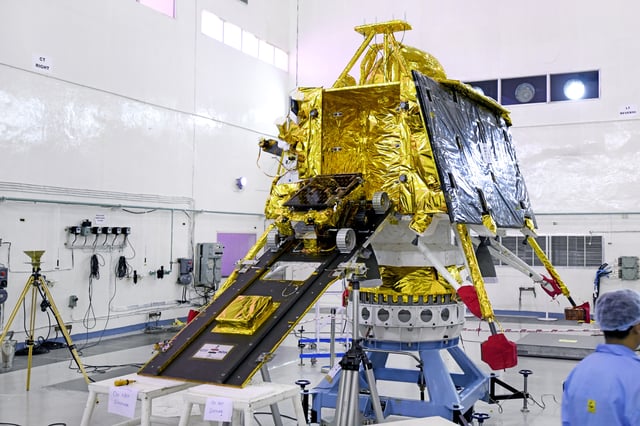
Rover Pragyan mounted on the ramp of Vikram lander

Images of the Earth captured by Chandrayaan-2 Vikram lander camera LI4[60]
The Vikram lander detached from the orbiter and descended to a low lunar orbit of 30 km × 100 km (19 mi × 62 mi) using its 800 N (180 lbf) liquid main engines. It then performed a comprehensive check of all its on-board systems before attempting a soft landing that would have deployed the rover, and perform scientific activities for approximately 14 Earth days. Vikram spacecraft apparently crash-landed.[30][1] The lander's location was spotted on the surface via thermal imaging, but its condition is unknown.[32] The approximate combined mass of the lander and rover is 1,471 kg (3,243 lb).[4][5]
The preliminary configuration study of the lander was completed in 2013 by the Space Applications Centre (SAC) in Ahmedabad.[38] The lander's propulsion system consists of eight 50 N (11 lbf) thrusters for attitude control and five 800 N (180 lbf) liquid main engines derived from ISRO's 440 N (99 lbf) Liquid Apogee Motor.[63][64] Initially, the lander design employed four main liquid engines, but a centrally mounted engine was added to handle new requirements of having to orbit the Moon before landing. The additional engine was expected to mitigate upward draft of lunar dust during the soft landing.[51] Vikram was designed to safely land on slopes up to 12°.[65][66]
Some associated technologies include a high resolution camera, Laser Altimeter (LASA),[67] Lander Hazard Detection Avoidance Camera (LHDAC), Lander Position Detection Camera (LPDC),[68] Lander Horizontal Velocity Camera (LHVC), an 800 N throttleable liquid main engine,[57] attitude thrusters, Ka band radio altimeters (KaRA),[69][70] Laser Inertial Reference & Accelerometer Package (LIRAP),[71] and the software needed to run these components.[2][55] Engineering models of the lander began undergoing ground and aerial tests in late October 2016, in Challakere in the Chitradurga district of Karnataka. ISRO created roughly 10 craters on the surface to help assess the ability of the lander's sensors to select a landing site.[72]
Pragyan rover

Pragyan rover of the Chandrayaan-2 mission
The mission's rover is called Pragyan (Sanskrit: प्रज्ञान, lit. 'Wisdom[73][74]') Pronunciation )[75][73] with a mass of 27 kg (60 lb), would have operated on solar power.[4][5] The rover was to move on 6 wheels traversing 500 meters on the lunar surface at the rate of 1 cm per second, perform on-site analyses and send the data to the lander, which would have relayed it to the Mission Control on the Earth.[76][77][37][56][52] For navigation, the rover uses:
Stereoscopic camera-based 3D vision: two 1 megapixel, monochromatic NAVCAMs in front of the rover to provide the ground control team a 3D view of the surrounding terrain, and help in path-planning by generating a digital elevation model of the terrain.[78] IIT Kanpur contributed to the development of the subsystems for light-based map generation and motion planning for the rover.[79]
Control and motor dynamics: the rover has a rocker-bogie suspension system and six wheels, each driven by independent brushless DC electric motors. Steering is accomplished by differential speed of the wheels or skid steering.[80]
The expected operating time of Pragyan rover was one lunar day, or around 14 Earth days, as its electronics were not designed to endure the frigid lunar night. However, its power system has a solar-powered sleep/wake-up cycle implemented, which could have resulted in longer service time than planned.[81][82] Two aft wheels of the rover have the ISRO logo and the State Emblem of India embossed on them to leave behind patterned tracks on the lunar surface,[83][84] which is used to measure the exact distance travelled, also called visual odometry.
Payload
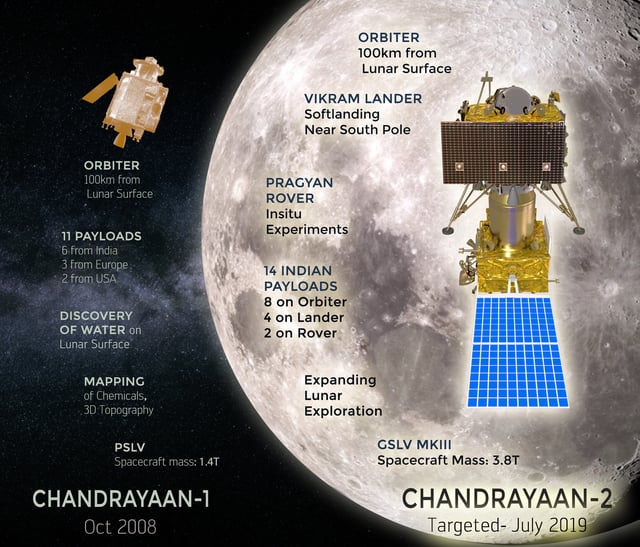
Mission overview
ISRO selected eight scientific instruments for the orbiter, four for the lander,[85][3][86] and two for the rover.[37] While it was initially reported that NASA and ESA would participate in the mission by providing some scientific instruments for the orbiter,[87] ISRO in 2010 had clarified that due to weight restrictions it will not be carrying foreign payloads on this mission.[88] However, in an update just a month before launch,[89] an agreement between NASA and ISRO was signed to include a small laser retroreflector from NASA to the lander's payload to measure the distance between the satellites above and the microreflector on the lunar surface.[90][91]
Orbiter
Chandrayaan-2 Large Area Soft X-ray Spectrometer (CLASS) from ISRO Satellite Centre (ISAC), makes use of X-ray fluorescence spectra to determine the elemental composition of the lunar surface.
Solar X-ray monitor (XSM) from Physical Research Laboratory (PRL), Ahmedabad for mapping major elements present on the lunar surface.[37]
Dual Frequency L and S band Synthetic Aperture Radar (DFSAR) from Space Applications Centre (SAC) for probing the first few meters of the lunar surface for the presence of different constituents, including water ice. DFSAR is expected to provide further evidence confirming the presence of water ice, and its distribution below the shadowed regions of the Moon.[37] It has lunar surface penetration depth of 5 meters (L-band).[59][86]
Imaging IR Spectrometer (IIRS) from Space Applications Centre (SAC) for mapping of lunar surface over a wide wavelength range for the study of minerals, water molecules and hydroxyl present.[37] It features an extended spectral range (0.8 μm to 5 μm) which is an improvement over previous lunar missions whose payloads worked up to 3 μm.[59][92][93]
Chandrayaan-2 Atmospheric Compositional Explorer 2 (ChACE-2) Quadrupole Mass Analyzer from Space Physics Laboratory (SPL) to carry out a detailed study of the lunar exosphere.[37]
Terrain Mapping Camera-2 (TMC-2) from Space Applications Centre (SAC) for preparing a three-dimensional map essential for studying the lunar mineralogy and geology.[37]
Radio Anatomy of Moon Bound Hypersensitive Ionosphere and Atmosphere – Dual Frequency Radio Science experiment (RAMBHA-DFRS) by SPL for the studying electron density in the Lunar ionosphere.
Orbiter High Resolution Camera (OHRC) by SAC for scouting a hazard-free spot prior to landing.
It will later help prepare high-resolution topographic maps and digital elevation models of the lunar surface. OHRC has spatial resolution of 0.3 m from 100 km polar orbit.[86]
Vikram lander
Instrument for Lunar Seismic Activity (ILSA) MEMS based Seismometer by LEOS for studying Moon-quakes near the landing site[85][13][94]
Chandra's Surface Thermo-physical Experiment (ChaSTE) Thermal probe by SPL, VSSC for estimating the thermal properties of the lunar surface[13]
RAMBHA-LP Langmuir probe by SPL, VSSC for measuring the density and variation of lunar surface plasma.[85][13]
A laser retroreflector array (LRA) by NASA Goddard Space Flight Center for taking precise measurements of distance between the reflector on the lunar surface and satellites in lunar orbit.[95][89][90] The micro-reflector weighs about 22 grams and can not be used for taking observations from Earth-based lunar laser stations.[90]
Pragyan rover
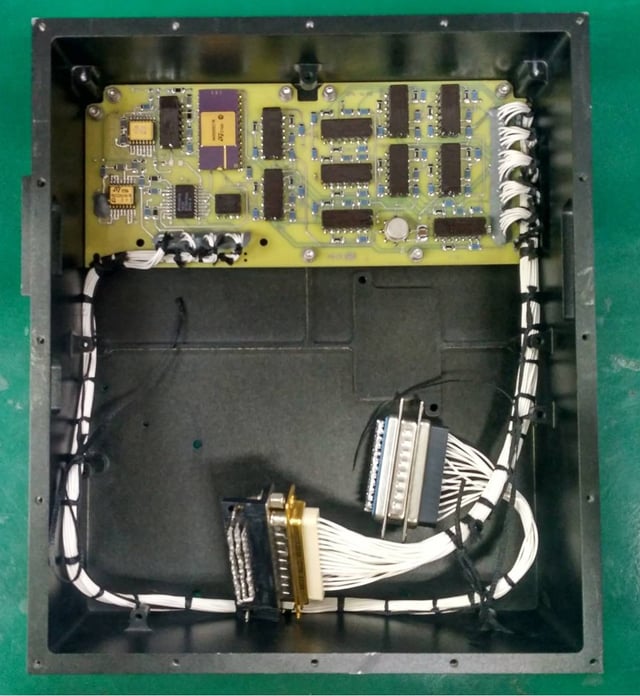
ChaSTE

APXS
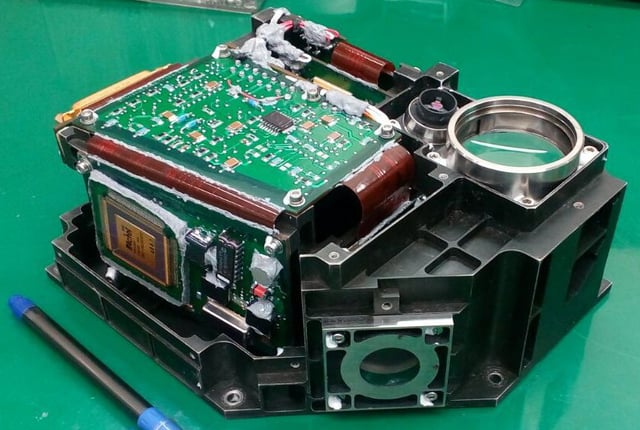
LIBS
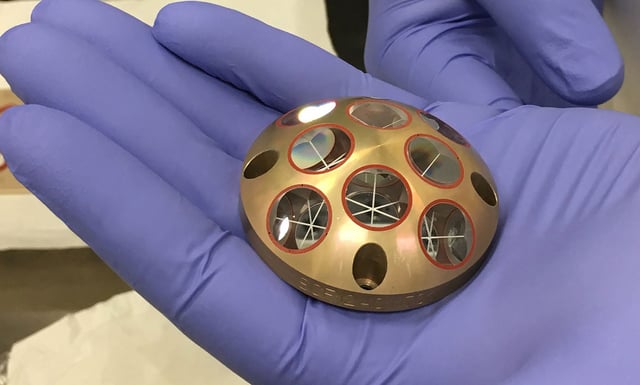
Laser retroreflector array (LRA)
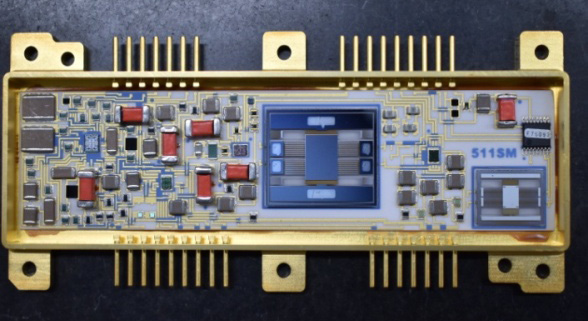
ILSA MEMS sensor package

CLASS
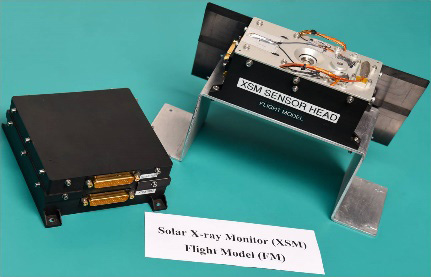
XSM
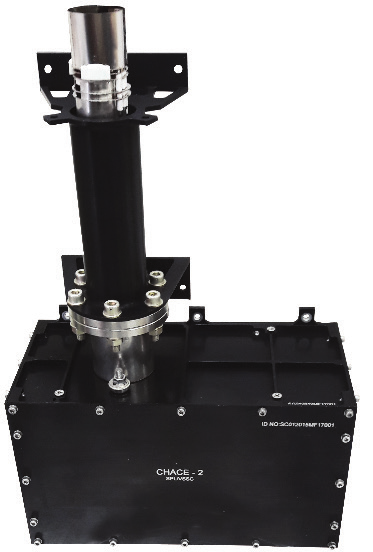
CHACE2
Mission profile
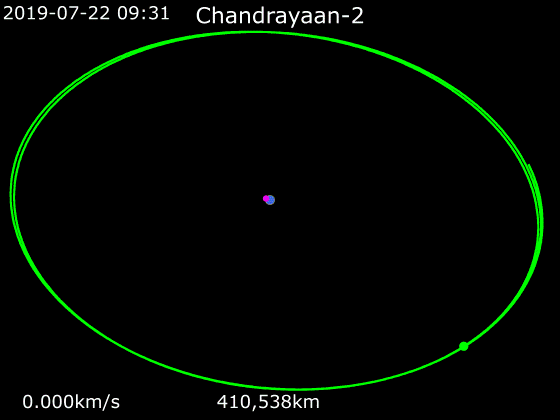
Overall motion of Chandrayaan-2
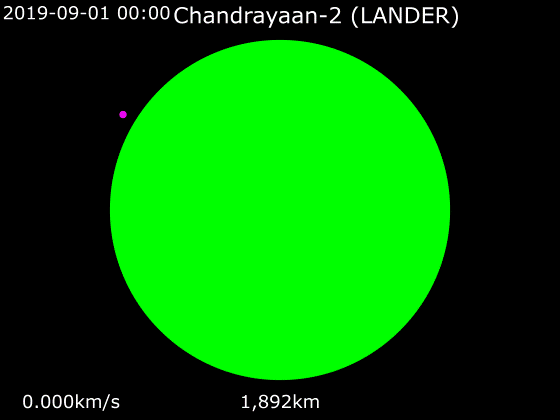
Lunar landing phase
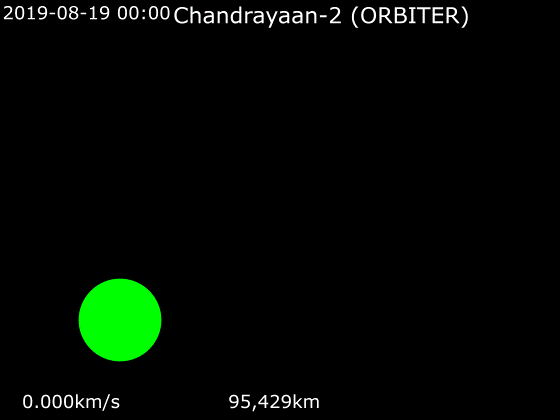
Selenocentric phase
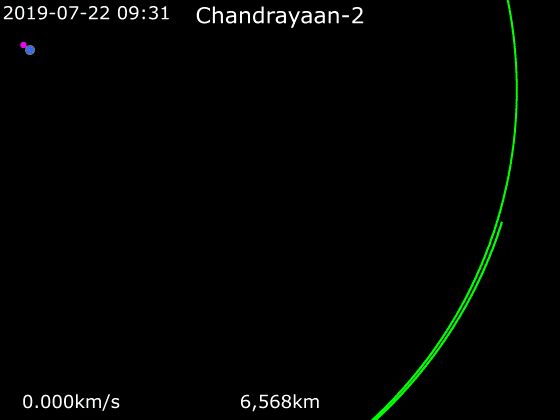
Geocentric phase

Chandrayaan-2 lifting off on 22 July 2019
| Phase | Date | Event | Detail | Result | References | |
|---|---|---|---|---|---|---|
| Apogee /Aposelene | Perigee /Periselene | |||||
| Geocentric phase | 22 July 2019 09:13:12 UTC | Launch | Burn time: 16 min 14 sec | 45,475 km (28,257 mi) | 169.7 km (105.4 mi) | [48] |
| 24 July 2019 09:22 UTC | 1st orbit-raising maneuver | Burn time: 48 sec | 45,163 km (28,063 mi) | 230 km (140 mi) | [100] | |
| 25 July 2019 19:38 UTC | 2nd orbit-raising maneuver | Burn time: 883 sec | 54,829 km (34,069 mi) | 251 km (156 mi) | [101] | |
| 29 July 2019 09:42 UTC | 3rd orbit-raising maneuver | Burn time: 989 sec | 71,792 km (44,609 mi) | 276 km (171.5 mi) | [102] | |
| 2 August 2019 09:57 UTC | 4th orbit-raising maneuver | Burn time: 646 sec | 89,472 km (55,595 mi) | 277 km (172 mi) | [103] | |
| 6 August 2019 09:34 UTC | 5th orbit-raising maneuver | Burn time: 1041 sec | 142,975 km (88,841 mi) | 276 km (171 mi) | [104] | |
| 13 August 2019 20:51 UTC | Trans-lunar injection | Burn time: 1203 sec | [105] | |||
| 20 August 2019 03:32 UTC | Lunar orbit insertion1st lunar bound maneuver | Burn time: 1738 sec | 18,072 km (11,229 mi) | 114 km (71 mi) | [106] | |
| 21 August 2019 07:20 UTC | 2nd lunar bound maneuver | Burn time: 1228 sec | 4,412 km (2,741 mi) | 118 km (73 mi) | [107] | |
| 28 August 2019 03:34 UTC | 3rd lunar bound maneuver | Burn time: 1190 sec | 1,412 km (877 mi) | 179 km (111 mi) | [108] | |
| 30 August 2019 12:48 UTC | 4th lunar bound maneuver | Burn time: 1155 sec | 164 km (102 mi) | 124 km (77 mi) | [109] | |
| 1 September 2019 12:51 UTC | 5th lunar bound maneuver | Burn time: 52 sec | 127 km (79 mi) | 119 km (74 mi) | [110] | |
| Vikramlunar landing | 2 September 2019 7:45 UTC | Vikramseparation | 127 km (79 mi) | 119 km (74 mi) | [111] | |
| 3 September 2019 3:20 UTC | 1st deorbit burn | Burn time: 4 sec | 128 km (80 mi) | 104 km (65 mi) | [112] | |
| 3 September 2019 22:12 UTC | 2nd deorbit burn | Burn time: 9 sec | 101 km (63 mi) | 35 km (22 mi) | [113] | |
| 6 September 2019 20:08 UTC | Powered descent | Burn time: 15 min | Landing (planned) | Landing (planned) | ||
| 6 September 2019 20:23 UTC | Vikramlanding | Trajectory deviation started at 2.1 km altitude,telemetrywas lost seconds before touchdown.[28][114] | ||||
| 7 September 2019 00:00 UTC-01:00 UTC (planned) | Pragyan roverdeployment | Lander failure, rover was not deployed. | [115][116] | |||
Launching of Chandrayaan 2
Chandrayaan-2 launch was initially scheduled for 14 July 2019, 21:21 UTC (15 July 2019 at 02:51 IST local time).[20] However, the launch was aborted 56 minutes and 24 seconds before launch due to a technical glitch, so it was rescheduled to 22 July 2019.[46][8] Unconfirmed reports later cited a leak in the nipple joint of a helium gas bottle as the cause of cancellation.[47][117][118]
Finally Chandrayaan-2 was launched on-board the GSLV MK III M1 launch vehicle on 22 July 2019 at 09:13 UTC (14:43 IST) with better-than-expected apogee as a result of the cryogenic upper stage being burned to depletion, which later eliminated the need for one of the apogee-raising burns during the geocentric phase of mission.[48][119][120] This also resulted in the saving of around 40 kg fuel onboard the spacecraft.[121]
Geocentric phase
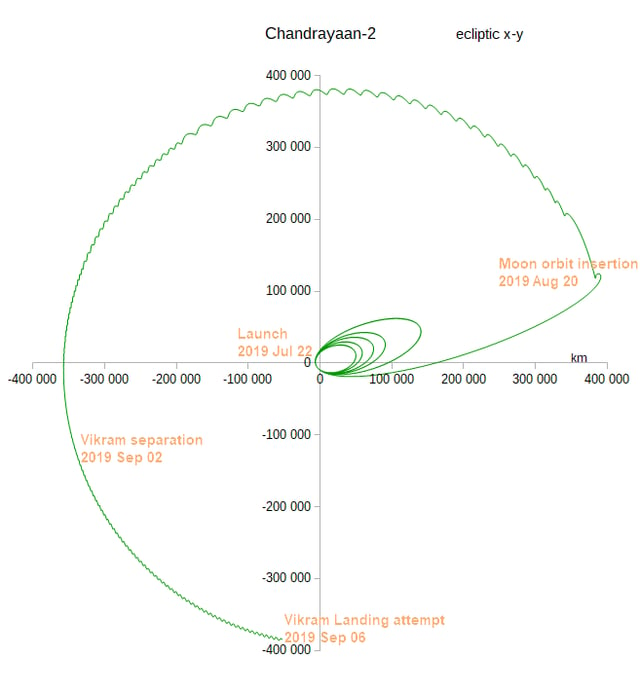
Chandrayaan-2 trajectory
After being placed into a 45,475 × 169 km parking orbit by the launch vehicle,[48] the Chandrayaan-2 spacecraft stack gradually raised its orbit using on-board propulsion over 22 days. In this phase, one perigee-raising and five apogee-raising burns were performed to reach a highly eccentric orbit of 142,975 × 276 km[104] followed by trans-lunar injection on 13 August 2019.[105] Such long Earth-bound phase with multiple orbit-raising manoeuvres exploiting the Oberth effect was required because of the limited lifting capacity of the launch vehicle and thrust of the spacecraft's on-board propulsion system. A similar strategy was used for Chandrayaan-1 and the Mars Orbiter Mission during their Earth-bound phase trajectory.[124] On 3 August 2019, the first set of Earth images were captured by the LI4 camera on the Vikram lander, showing North American landmass.[60]
Selenocentric phase
After 29 days from its launch, the Chandrayaan-2 spacecraft stack entered lunar orbit on 20 August 2019 after performing a lunar orbit insertion burn for 28 minutes 57 seconds. The three-spacecraft stack was placed into an elliptical orbit that passes over the polar regions of the Moon, with 18,072 km (11,229 mi) aposelene and 114 km (71 mi) periselene.[106] By 1 September 2019 this elliptical orbit was made nearly circular with 127 km (79 mi) aposelene and 119 km (74 mi) periselene after four orbit-lowering maneuvers[107][108][109][110] followed by separation of Vikram lander from the orbiter on 7:45 UTC, 2 September 2019.[111]
Planned landing site
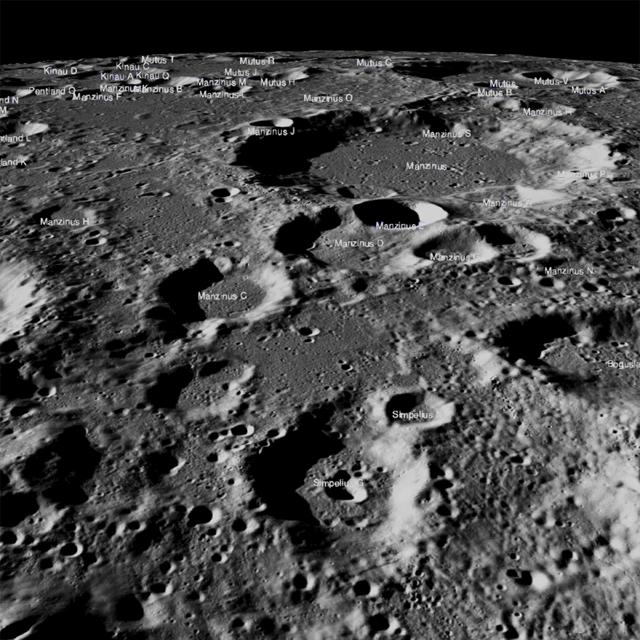
The flat highland between craters Manzinus C and Simpelius N was the planned landing zone for the Vikram lander
Two landing sites were selected, each with a landing ellipse of 32 × 11 km.[125] The prime landing site (PLS54) is at 70.90267 S 22.78110 E (600 km (370 mi) from the south pole[126]), and the alternate landing site (ALS01) is at 67.874064 S 18.46947 W. The prime site is on a high plain between the craters Manzinus C and Simpelius N,[127][26] on the near side of the Moon.
Hard landing of Vikram
Vikram began its descent at 20:08:03 UTC, 6 September 2019 and was scheduled to land on the Moon at around 20:23 UTC. The descent and soft-landing were to be done by the on-board computers on Vikram, with mission control unable to make corrections.[128]
The initial descent was considered within mission parameters, passing critical braking procedures as expected, but the lander's trajectory began to deviate at about 2.1 kilometres (1.3 mi; 6,900 ft) above the surface.[129][130] The final telemetry readings during ISRO's live-stream show that Vikram's final vertical velocity was 58 m/s (210 km/h) at 330 meters above the surface which, according to some experts, is quite fast for a lunar landing.[28][114][131] Initial reports suggesting a crash[30][31] were confirmed by ISRO chairman K. Sivan, stating that the lander location was found and that "it must have been a hard landing".[32][132][133]
Radio transmissions from the lander were tracked during descent by analysts using a 25-meter radio telescope owned by the Netherlands Institute for Radio Astronomy. Analysis of the doppler data suggests that the loss of signal coincided with the lander impacting the lunar surface at a velocity of nearly 50 metres (160 ft) per second (as opposed to an ideal 2 metres (6.6 ft) per second touchdown velocity).[3][134]
The powered descent was also observed by NASA's Lunar Reconnaissance Orbiter (LRO) using its Lyman-Alpha Mapping Project (LAMP) instrument to study changes in the lunar exosphere due to exhaust gases from the lander's engines.[135]
Status
The mission's orbiter used thermal imaging to locate the lander.[136] Unconfirmed reports, citing an ISRO official, stated that the lander was intact,[137] but there has been no official announcement by ISRO on the lander's physical condition.[32][138] ISRO's Chairman, K. Sivan, tasked senior scientist P. S. Goel to head the Failure Analysis Committee to look into the causes of the failure.[139] Both ISRO and NASA attempted to communicate with the lander for about two weeks before the lunar night set in.[140][141] while NASA's Lunar Reconnaissance Orbiter (LRO) flew over on 17 September 2019 and acquired some images of the intended landing zone.[142] However, the location was near dusk, causing poor lighting for optical imaging.[143][144] NASA's LRO images, showing no sight of the lander, were released on 26 September.[126] The LRO will fly over again on 14 October under more favorable lighting conditions.[145]
The lander and rover were primarily engineering tests,[146] and the lander's success criteria was defined for every phase, scoring 90% to 95%.[146] The orbiter part of the mission, with eight scientific instruments, remains operational, and will continue its seven-year mission to study the Moon.[130]
Team
Ritu Karidhal – Mission Director
Muthayya Vanitha – Project Director
K. Kalpana – Associate Project Director[151]
G. Narayanan – Associate Project Director[152]
G. Nagesh – Project Director (former)[153]
Chandrakanta Kumar – Deputy Project Director (Radio frequency systems)
Amitabh Singh – Deputy Project Director (Optical Payload Data Processing, SAC)[154]
See also
Chandrayaan programme
Chandrayaan-1 - First lunar mission of the Chandrayaan programme
Beresheet lander - Concurrent lunar lander mission, crash-landed on the Moon
Exploration of the Moon
List of current and future lunar missions
List of ISRO missions
Lunar resources
